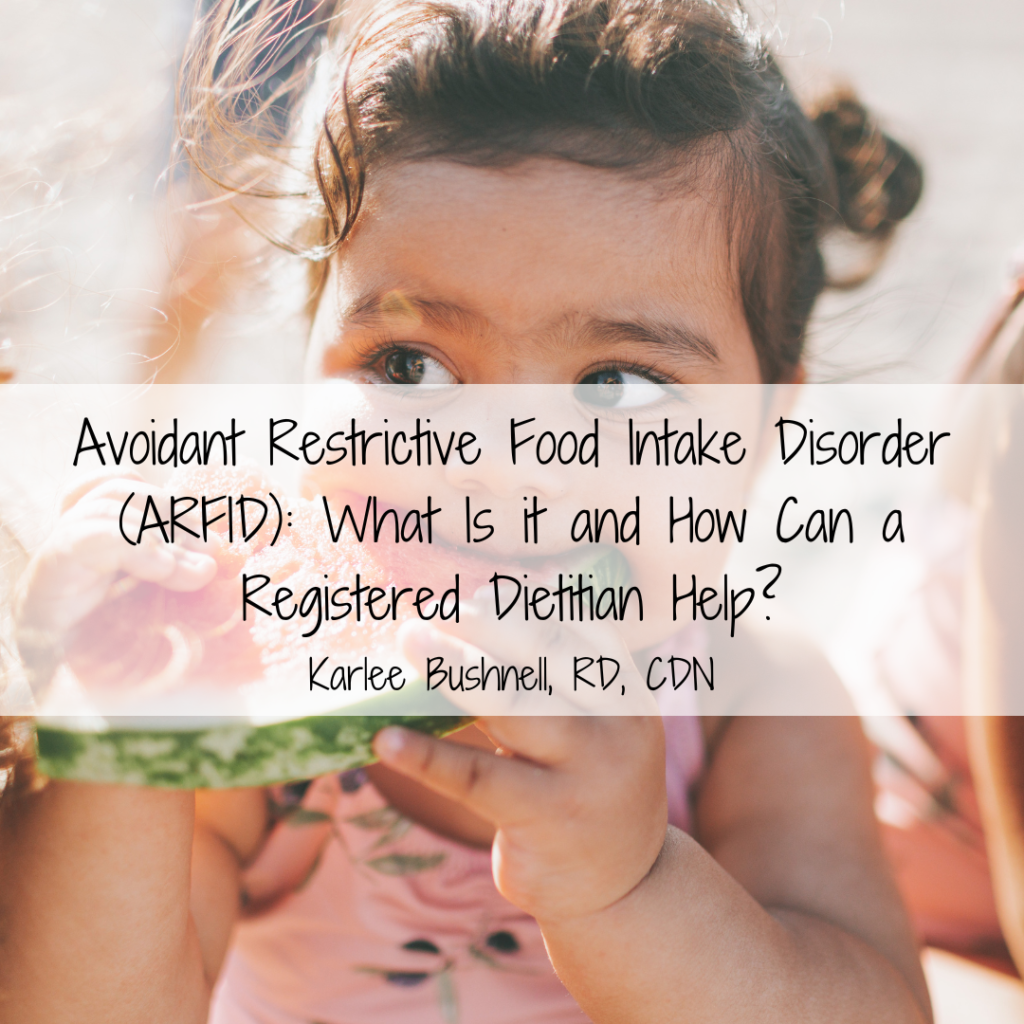
Avoidant Restrictive Food Intake Disorder (ARFID) is a relatively new eating disorder (ED) diagnosis that was added to the Diagnostic and Statistical Manual of Mental Disorders (DSM-5) in 2013. This diagnosis was introduced to better categorize individuals who experience severe challenges with eating, but do not fit the criteria for anorexia or bulimia nervosa.
ARFID presents unique hurdles impacting individuals’ relationships with food and overall well-being. For those navigating the complexities of ARFID, finding effective strategies is essential for gradually expanding their food choices and improving their nutritional intake. In this post, we’ll explore more on what ARFID is, as well as practical strategies to help individuals with ARFID cope with and overcome the associated challenges.
ARFID is typically characterized more by a limited range of preferred foods and an avoidance of certain sensory components, rather than concerns about body image or weight. However, given how prevalent diet culture is in our society, I think it’s important to note that many individuals can experience concerns related to body image or weight without a formal ED diagnosis and/or alongside a diagnosis of ARFID. Additionally, as per Dr. Jennifer Gaudiani, MD, CEDS, FAED, in her book “Sick Enough: A Guide to the Medical Complications of Eating Disorders”, she notes that “weight loss and underweight are potential triggers for anorexia nervosa, and ARFID can morph into anorexia nervosa if untreated”.
Diagnostic Criteria for ARFID (Based on the DSM-5):An eating or feeding disturbance (e.g., lack of interest in eating or food; avoidance of sensory aspects of food; concern about what may happen if they do eat). In addition, patients with this diagnose must experience at least one of the following four criteria:
- Weight loss (or arrested growth in children)
- Nutritional deficiency
- Dependence on enteral feeding or oral nutritional supplements
- Marked interference with psychosocial functioning
Potential Causes of ARFID: The exact causes of ARFID are not yet fully understood, but various factors may contribute to the development of this disorder, including but not limited to: sensory sensitivities, neurodivergence, a history of gastrointestinal issues, traumatic experiences related to food, a predisposition to anxiety disorders, as well as cultural/social components (i.e diet culture, fatphobia, healthism, ableism).
Symptoms of ARFID:
1. Selective Eating: Individuals with ARFID often have an extremely limited range of preferred foods. This can be due to sensory sensitivities, fear of consequences related to eating (such as emesis or choking) or negative past experiences related to certain foods.
2. Texture Aversion: Aversion to specific textures of food, regardless of taste or nutritional value, is a common symptom of ARFID.
3. Limited Interest in Food: ARFID is primarily characterized by a lack of interest in food. As touched on, individuals with ARFID may not be motivated by a desire to lose weight or change their bodies, but rather by a genuine disinterest in eating.
4. Nutritional Deficiencies: Individuals with ARFID are at a higher risk of nutritional deficiencies as well as overall malnutrition. This can lead to a range of medical consequences including fatigue, weakened immune system, and developmental delays in children.
Strategies to treat ARFID:
- Seek Professional Support
The guidance of mental health professionals and Registered Dietitians (RDs) specializing in eating disorders is invaluable for individuals with ARFID. These experts can provide personalized strategies, coping mechanisms, and ongoing support throughout the journey of expanding food choices. According to Lauren Sharifi, a RD who specializes in ARFID, some ways that a RD can help with ARFID are as follows:
- Reduce mealtime and feeding anxiety.
- Assess potential nutrition deficiencies and provide appropriate recommendations as needed.
- Assess barriers to feeding including causes of feeding or eating difficulties.
- Referrals to additional health care providers (i.e therapist, occupational or speech therapist), as needed.
- Provide/recommend accommodations to make the eating environment feel safe and comfortable.
- Make safe and preferred foods more accessible and available.
- Promote strategies for simplifying eating, meal planning and food preparation that work for the individual.
- Non-diet nutrition education.
- Help identify foods that fit sensory preferences.
- Client led food exploration.
Long Term Goals of Working with a Dietitian for ARFID
- Reduced meal time and food anxiety
- Accessible eating and meal preparation strategies
- Increased number of accepted foods ( if desired by the client)
- An individualized plan for how to approach feeding and introducing new foods
- Improved quality of life
- Weight restoration or growth
- Resolved nutrition deficiencies
- Gradual Exposure Therapy
One of the primary approaches for ARFID is gradual exposure therapy. This involves systematically introducing new foods in a step-by-step manner, which allows individuals to become more comfortable with different sensory characteristics of food.
- Building a Safe Food Hierarchy
Creating a hierarchy of preferred and non-preferred foods can be a helpful tool in the journey towards expanding the diet. This involves categorizing foods based on the individual’s comfort level, starting with those that feel the safest and gradually progressing to more challenging options as the client feels able to. Once you create the hierarchy it can also be helpful to look for common denominators to better understand preferences, such as:
- Preferred texture
- Patterns around temperature of foods
- Preference for sweet vs savory or liquids vs solids
- Acceptance of certain food colors
- Food Chaining
Food chaining is a technique that involves introducing new foods that share similarities with familiar, preferred foods. This method leverages existing preferences to gently broaden the range of acceptable foods. For example, a favorite food of chicken nuggets to chain to a new food of fish may look like:Food Chain:
- Store bought chicken nuggets
- Homemade breaded chicken nuggets
- Homemade breaded chicken strips
- Store bought breaded fish sticks
- Homemade breaded fish sticks
- Lightly breaded baked cod
Overall, treatment for ARFID is a gradual process that requires patience, understanding, and a multifaceted approach. One of the challenges with ARFID is that it often goes undiagnosed or misdiagnosed due to its unique characteristics. More detrimentally, it can be written off as no more than picky eating which significantly underscores the severity of the condition. Raising awareness about ARFID is crucial to help individuals and their families recognize the signs and seek appropriate support.
A client recently shared with me that they view their experience with ARFID as more of an eating disability versus eating disorder, and therefore view their appointments and strategies to prioritize nutrition as necessary accommodations to support themselves. If this resonates with you, I hope that you can find compassionate and expert care on your journey of finding accommodations; every step towards improving your relationship to food is a victory worth celebrating.
If you believe that you or someone you know is experiencing symptoms of ARFID, please reach out to our team for further support: https://pearlsofnutrition.com/work-with-us/
Sources:
- American Psychiatric Association. (2013). Diagnostic and statistical manual of mental disorders (5th ed.). https://doi.org/10.1176/appi.books.9780890425596
- Gaudiani, J.L. (2018). Sick Enough: A Guide to the Medical Complications of Eating Disorders (1st ed.). Routledge. https://doi.org/10.4324/9781351184731
- https://laurensharifi.com/arfid-dietitian/
- https://peaceandnutrition.com/food-chaining-as-a-tool-to-nourish/


